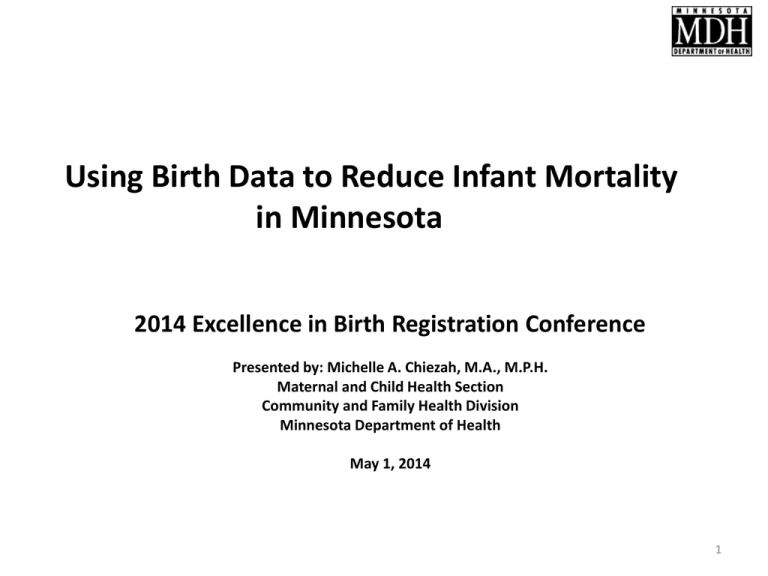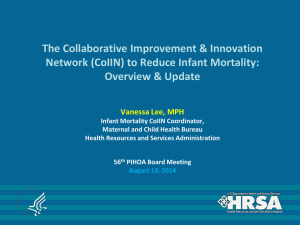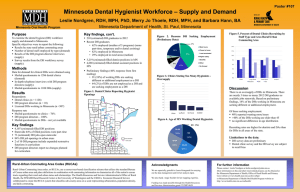Infant Mortality In Minnesota - Minnesota Department of Health
advertisement

Using Birth Data to Reduce Infant Mortality in Minnesota 2014 Excellence in Birth Registration Conference Presented by: Michelle A. Chiezah, M.A., M.P.H. Maternal and Child Health Section Community and Family Health Division Minnesota Department of Health May 1, 2014 1 Background 2 Minnesota’s Infant Mortality Reduction Initiative (MIMRI) • Is an effort of the Minnesota Department of Health to improve birth outcomes and reduce infant mortality in Minnesota with an emphasis on reducing disparities in rates (e.g., racial/ethnic). • MIMRI provides the following: – Statewide leadership – Resources – Education and information – Technical assistance to tribal governments, local public health departments, and community agencies • MIMRI also uses the most current data (e.g., vital records) to help plan, coordinate, and evaluate interventions and activities. – • Birth Data are Essential!! MIMRI has numerous partners including: MN Chapter of the March of Dimes, Minnesota Perinatal Organization, Tribal Governments, Local Public Health Departments, Twin-Cities Healthy Start, WIC, MN Center for Health Statistics, Office of Minority and Multicultural Health (OMMH), to name a few! 3 What is Infant Mortality? Infant mortality is the death of an infant before age one. 4 What Is the Infant Mortality Rate? • The infant mortality rate (IMR) is expressed as the number of infant deaths per 1,000 live births. • For example: In 2011, there were 324 infant deaths and 68,783 live births in Minnesota. What was the infant mortality rate? 324/68,783 x 1,000 = 4.7 infant deaths per 1,000 live births Interpretation: In 2011, the IMR in Minnesota was 4.7 infant deaths per 1,000 live births. 5 What Does the Infant Mortality Rate Indicate or Suggest? • The IMR is one of the most important indicators of health. • The IMR reflects “…a variety of factors such as maternal health, quality and access to medical care, socioeconomic conditions, and public health practices.”1 1MacDorman MF, Mathews TJ. Recent Trends in Infant Mortality in the United States. NCHS data brief, no 9. Hyattsville, MD: National Center for Health Statistics. 2008. 6 Disparities 7 What is a health disparity? 8 A health disparity is not: • A type of disease or a health condition. • A person of color with a disease or health condition. • A poor person or other persons from disparate populations with a disease or other adverse health conditions. 9 Health disparities are: “Differences in the incidence, prevalence, mortality and burden of disease and other adverse health conditions that exists between specific populations groups.” Source: “Advancing Health Equity in Minnesota.” Minnesota Department of Health (Flyer). http://www.health.state.mn.us/divs/chs/healthequity/definitions2013.pdf. 21 October 2003. Accessed on 4/25/2014. 10 Some Data 11 Infant Mortality Reporting • Data Source – Linked Infant Death/Birth Data Set • Match the death of the infant to its birth • Race reported as mother’s race • Reported by birth year 12 Number of Births in Minnesota, 2000-2011 80,000 70,000 67,451 70,053 70,614 66,617 68,037 70,920 73,515 73,675 72,382 70,083 68,407 68,783 Number of Births 60,000 50,000 40,000 30,000 20,000 10,000 0 2000 2001 2002 2003 2004 2005 2006 2007 2008 2009 2010 2011 Year Source: Minnesota Center for Health Statistics 13 Number of Infant Deaths in Minnesota, 2000-2011 500 450 400 404 380 346 Number of Births 350 370 353 324 325 2003 2004 429 375 315 313 324 300 250 200 150 100 50 0 2000 2001 2002 2005 2006 2007 2008 2009 2010 2011 Year Source: Minnesota Center for Health Statistics 14 Percent of Black/African American Births by Maternal Nativity in Minnesota, 1990-2010 100.0 90.0 80.0 Percent 70.0 60.0 50.0 40.0 30.0 20.0 Foreign-born 10.0 U.S. Born 0.0 1990 1991 1992 1993 1994 1995 1996 1997 1998 1999 2000 2001 2002 2003 2004 2005 2006 2007 2008 2009 2010 Year Source: MDH, MCHS linked Infant Death/Birth File 15 Infant Mortality Rates by Year of Birth in Minnesota and U.S. (3-year Averages) 8 7.2 7.1 Rate per 1,000 Live Births 7 6 5.9 5.9 7.0 5.9 6.9 6.9 6.9 6.9 6.8 6.8 6.7 6.6 6.3 5.6 5.3 5 6.8 5.0 4.8 4.8 5.0 5.3 5.5 5.3 5.0 4 Healthy People 2020 Goal: 6.0 infant deaths per 1000 Live births 3 2 U.S. Minnesota 1 0 Year Source: National Center for Health Statistics 16 Infant Mortality Rates by Geography1 in Minnesota, 2006-2010 8 6.9 7 Rate per 1,000 Live Births 6 5 5.1 5.2 5.1 4.7 5.1 West Central Total 4.3 4.1 4 5.1 3 2 1 0 Central Metro Northeast Northwest South Central South East Southwest Geography 1Geographic classification is based on Minnesota’s 50 health boards which are grouped into 8 geographic regions Community Health Boards by SCHSAC Region. Community Health Services Advisory Committee. http://www.health.state.mn.us/divs/cfh/ophp/about/maps.html Sources: Minnesota Department of Health, Center for Health Statistics. 17 Infant Mortality Rates by Race/Ethnicity of Mother in Minnesota, 1995-1999 and 2006-2010 16 14 1995-1999 2006-2010 13.5 12.9 Rate per 1,000 Live Births 12 10 9.8 9.1 8 7.1 6.8 6.2 6 4.9 4.8 5.5 5.1 4.4 4 2 0 African-American American Indian Asian Hispanic* White Total Race/Ethnicity *Can be of any race Source: Minnesota Department of Health, Center for Health Statistics 18 Leading Causes of Infant Deaths in Minnesota, 2006-2010 Rank Cause of Death Number Percent Cumulative Percent 1 Congenital Anomalies 469 25.5 25.5 2 Prematurity 353 19.3 44.8 3 SIDS/Sleep Disorders* 253 13.8 58.6 4 Obstetric Conditions 202 11.0 69.6 5 Injury 41 2.2 71.8 All Other 518 28.2 100.0 1,836 100.0 Total Source: Minnesota Department of Health, Center for Health Statistics * The SIDS category includes Sudden Infant Death Syndrome and other sleep-related infant deaths. 19 Leading Causes of Infant Deaths by Race/Ethnicity of Mother in Minnesota, 2006-2010 Rank White African American American Indian Asian Hispanic 1 Congenital Anomalies Prematurity SIDS/Sleep Disorders * Congenital Anomalies Congenital Anomalies 2 Prematurity Congenital Anomalies Congenital Anomalies Prematurity Prematurity 3 SIDS/Sleep Disorders * SIDS/Sleep Disorders* Prematurity Obstetric Conditions SIDS/Sleep Disorders* 4 Obstetric Conditions Obstetric Conditions SIDS/Sleep Disorders * Obstetric Conditions 5 Injury Birth Asphyxia Injury Obstetric Conditions Birth Asphyxia Birth Asphyxia and Injury(tied) Source: Minnesota Department of Health, Center for Health Statistics *The SIDS category includes Sudden Infant Death Syndrome and other sleep-related infant deaths. 20 Source: Disparities in Infant Mortality, January 2009 http://www.health.state.mn.us/divs/chs/infantmortality/infantmortality09.pdf 21 Contributing Factors to Infant Mortality • Individual -Mother ( Health, Demographic, ...) -Infant ( Birth Health Status ) • Environment / Community -Physical (Housing, Safety, Environmental Hazards, . . ) -Economic (Income, Employment, Education, . . ) -Social (Culture, Racism, Stress, . . .) • Systems -Health Care Delivery -Public Health (National, State, Local) 22 Infant Mortality in Minnesota by Selected Contributing Factors • • • • • Age of Mother Adequacy of prenatal care Infant Birth Weight Infant Gestational Age Maternal Education 23 Infant Mortality Rates by Age and Race/Ethnicity of Mother in Minnesota, 2006-2010 Under 20 years 20 to 34 years 16 35 years and older 14.7 Rate per 1,000 Live Births 14 12 10 8 11.2 10.4 9.4 9.1 8.9 8.5 7.7 5.8 6 5.7 4.8 4.3 4.1 Asian Hispanic* Race/Ethnicity 4 4.8 4.1 4.7 5.4 2 0 African-American American Indian *Can be of any race Source: Minnesota Department of Health, Center for Health Statistics White Total 24 Leading Causes of Infant Deaths by Age of Mother in Minnesota, 2006-2010 Rank All Under 20 years 20 to 34 years 35 years and older 1 Congenital Anomalies SIDS/Sleep Disorders* Congenital Anomalies Congenital Anomalies 2 Prematurity Prematurity Prematurity Prematurity 3 SIDS/Sleep Disorders * Congenital Anomalies SIDS/Sleep Disorders Obstetric Conditions 4 Obstetric Conditions Obstetric Conditions Obstetric Conditions SIDS/Sleep Disorders * 5 Injury Injury Injury Injury Source: Minnesota Department of Health, Center for Health Statistics *The SIDS category includes Sudden Infant Death Syndrome and other sleep-related infant deaths. 25 Infant Mortality Rates by Adequacy of Prenatal Care and Race/Ethnicity of Mother in Minnesota, 2006-2010 16 Intensive/Adequate Rate per 1,000 Live Births 14 Inadequate/None 12.9 12.1 12 10.7 9.8 10 8.4 8 6.3 6 4.2 4.1 4 3.2 3.7 3.4 3.9 2 0 African-American American Indian Asian Hispanic* Race/Ethnicity White Total *Can be of any race Source: Minnesota Department of Health, Center for Health Statistics 26 Leading Causes of Infant Deaths in Minnesota by Adequacy of Prenatal Care, 2006-2010 Rank 1 All Intensive/ Adequate Care Inadequate/No Care Congenital Anomalies Congenital Anomalies Congenital Anomalies 2 Prematurity SIDS/Sleep Disorders Prematurity 3 SIDS/Sleep Disorders * Prematurity SIDS/Sleep Disorders 4 Obstetric Conditions Obstetric Conditions Obstetric Conditions 5 Injury Injury Injury Source: Minnesota Department of Health, Center for Health Statistics *The SIDS category includes Sudden Infant Death Syndrome and other sleep-related infant deaths. 27 Infant Mortality Rates by Infant Birth Weight and Race/Ethnicity of Mother in Minnesota, 2006-2010 80.0 70.0 67.8 <2,500g 62.8 >=2,500g Rate per 1,000 Live Births 60.0 53.0 47.4 50.0 43.1 40.0 37.7 30.0 20.0 10.0 3.3 4.7 1.8 1.8 1.9 2.1 0.0 African-American American Indian Asian Race/Ethnicity *Can be of any race Source: Minnesota Center for Health Statistics Hispanic* White Total Leading Causes of Infant Deaths by Infant Birth Weight in Minnesota, 2006-2010 Rank All Less than 2,500 grams 2,500 grams or more. 1 Congenital Anomalies Prematurity SIDS/Sleep Disorders* 2 Prematurity 3 Congenital Anomalies Congenital Anomalies SIDS/Sleep Disorders * Obstetric Conditions Injury 4 Obstetric Conditions SIDS/Safe Sleep Disorder Obstetric Conditions 5 Injury Injury Prematurity Source: Minnesota Department of Health, Center for Health Statistics *The SIDS category includes Sudden Infant Death Syndrome and other sleep-related infant deaths. 29 Age at Death and Infant Mortality Rates in Minnesota by Race/Ethnicity of Mother, 2006-2010 8 Rate per 1,000 Live Births 7 Neonatal(<28 days) Post-Neonatal(28 to 364 days) 6.5 6 5.1 5 4 4.0 3.3 3.6 3.2 2 1.3 3.3 2.9 3 1.6 1.6 1.8 1 0 African-American American Indian Asian Hispanic* Race/Ethnicity White Total *Can be of any race Source: Minnesota Department of Health, Center for Health Statistics 30 Leading Causes of Infant Deaths by Age at Death In Minnesota, 2006-2010 Rank All Neonatal Post Neonatal 1 Congenital Anomalies Prematurity SIDS/Sleep Disorders* 2 Prematurity 3 Congenital Anomalies Congenital Anomalies SIDS/Sleep Disorders * Obstetric Conditions Injury 4 Obstetric Conditions SIDS/Safe Sleep Disorder Prematurity 5 Injury Injury Injury Source: Minnesota Department of Health, Center for Health Statistics *The SIDS category includes Sudden Infant Death Syndrome and other sleep-related infant deaths. 31 Infant Mortality Rates by Infant Gestational Age and Race/ Ethnicity of Mother in Minnesota, 2006-2010 55.0 Rate per 1,000 Live Births 50.0 <37 Weeks >=37 Weeks 47.8 45.0 40.0 34.3 35.0 30.0 29.2 26.2 25.7 25.0 23.0 20.0 15.0 10.0 5.0 3.5 4.5 1.8 2.0 1.9 2.1 0.0 African-American American Indian Asian Race/Ethnicity *Can be of any race Source: Minnesota Center for Health Statistics Hispanic* White Total Leading Causes of Infant Deaths by Gestational Age in Minnesota, 2006-2010 Rank All <37 Weeks (preterm) >=37 Weeks (fullterm) 1 Congenital Anomalies Prematurity Congenital Anomalies 2 Prematurity Congenital Anomalies SIDS/Sleep Disorders* 3 SIDS/Sleep Disorders * Obstetric Conditions Injury 4 Obstetric Conditions SIDS/Safe Sleep Disorder Obstetric Conditions 5 Injury Injury Prematurity Source: Minnesota Department of Health, Center for Health Statistics *The SIDS category includes Sudden Infant Death Syndrome and other sleep-related infant deaths. 33 Infant Mortality Rates in Minnesota by Race and Education of Mother, 2006-2010 Rate per 1,000 births 10.0 2.5 9.9 9.4 2.0 2.1 1.6 1.7 8.0 1.5 6.8 6.0 5.7 1.0 4.8 4.0 3.4 2.0 0.0 0.5 African American/White Ratio 12.0 0.0 Less than High School African American High School Mother’s Education White Greater than High School African American : White Ratio Source: MDH, MCHS Linked Infant Death/Birth File 34 Leading Causes of Infant Deaths by Maternal Education in Minnesota, 2006-2010 Rank 1 All Less than High School College Graduate Congenital Anomalies Congenital Anomalies Congenital Anomalies 2 Prematurity SIDS/Sleep Disorders* Prematurity 3 SIDS/Sleep Disorders * Prematurity Obstetric Conditions 4 Obstetric Conditions Obstetric Conditions SIDS/Sleep Disorders* 5 Injury Injury Injury *The SIDS category includes Sudden Infant Death Syndrome and other sleep-related infant deaths Source: Minnesota Department of Health, Center for Health Statistics 35 The Data are Used to Inform Local Efforts 36 Examples of Past or Ongoing Infant Mortality Activities/Programs in Minnesota Healthy Babies are Worth the Wait Campaign American Indian Community Action Teams MN Prematurity Coalition Twin Cities Healthy Start Eliminating Health Disparities grants 2013 Breastfeeding Summit DHS Elective Induction Coverage Policy MN Medicaid Family Planning Waiver MDH Preconception Health Work Group Infant Mortality Reduction Plan Low Birth Weight Initiative MDH Health Equity Efforts 37 The Data help to Inform Regional & National Efforts! 38 Region V CoIIN 39 Federally Designated Public Health and Human Services Regions Regions IV and VI states: Alabama, Arkansas, Florida, Georgia, Kentucky, Louisiana, Mississippi, New Mexico, North Carolina, Oklahoma, South Carolina, Tennessee, and Texas. 40 Definition A Collaborative Improvement and Innovation Network (CoIIN) has been defined as a “cyberteam of self-motivated people with a collective vision, that innovatively collaborate by sharing ideas, information, and work enabled by technology.”1 1Gloor, PA. Swarm Creativity: Competitive Advantage through collaborative Innovation Networks. New York, NY: Oxford University Press, 2006. 41 Infant Mortality Rates by Race/Ethnicity Among States in Region V, 2008-2010 Total NonHispanic Black Illinois 7.0 13.6 Non-Hispanic American Indian or Alaska Native1 -- Asian or Pacific Islander Hispanic NonHispanic White Region V Rank 5.5 5.8 5.5 3 Indiana 7.4 14.1 -- 6.8 6.5 4 Michigan 7.4 14.3 12.3 4.5 6.9 5.9 4 Minnesota 5.0 9.6 8.6 4.8 4.6 4.6 1 Ohio 7.7 14.5 -- 4.5 7.3 6.3 5 Wisconsin 6.3 13.9 8.0 6.4 6.2 5.4 2 U.S. 6.4 12.2 8.4 4.8 5.1 9.0 N/A 6.1 Source: National Center for Health Statistics *Ranking is from best to worst, i.e., Minnesota has the lowest (best) infant mortality rate in region V --Data not available. 1 Includes Aleuts and Eskimos 42 Purposes of Region V CoIIN • Region V CoIIN encourages2: – Distance-based communication using existing technologies (e.g., web). – Innovation as well as constant communication of cyberteam members across various levels of the network. – Cyberteam members to engage in collaborative learning, work, and the development, implementation, and evaluation of strategies to address a problem. Sources: 1Gloor, PA. Swarm Creativity: Competitive Advantage through collaborative Innovation Networks. New York, NY: Oxford University Press, 2006. 2Ghandour, RM. Collaborative Improvement and Innovation Network (COIN) to Reduce Infant Mortality. Secretary’s Advisory Committee on Infant Mortality. Bethesda, Maryland. www.hrsa.gov/advisorycommittees/mchbadvisory/.../Meetings/.../coin.pp...Accessed on: 7/19/2013. 43 Region V CoIIN The Four topics selected for Region V’s CoIIN are: 1. 2. 3. 4. Social Determinants of Health SIDS/SUIDS/Safe Sleep Preconcpetion Health/Interconception Care Early Elective Deliveries 44 Draft Infant Mortality Plan Recommendations 1. Improve health equity and address the social determinants of health that most significantly impact disparities in birth outcomes. 2. Reduce the rate of SIDS/SUIDS deaths in Minnesota. 3. Assure a comprehensive statewide system that monitors infant mortality. 4. Provide comprehensive, culturally-appropriate, coordinated health care to all women during the preconception, pregnancy and post-partum periods. 5. Reduce the rate of preterm births in Minnesota. 6. Improve the rate of pregnancies that are planned, including reducing the rate of teen pregnancies. 7. Establish an ongoing task force of stakeholders to oversee implementation of recommendations and action steps. 45 The Data help to Inform Research! 46 2012 Preconception Health Databook Preconception Health and Health Care Indicators Databook, Minnesota, 2004- 2008. Minnesota Department of Health, St. Paul, Minnesota. September 2012 http://www.health.state.mn.us/divs/fh/mch/preconception/documents/preconcept iondatabook.pdf 47 “Unnatural Causes: When the Bough Breaks” http://www.unnaturalcauses.org/episode_descriptions.php?page=2 48 49 • It is estimated that in the U.S., about 11,300 babies die each year on the same day they are born. • The highest among industrialized countries. • About 50% more infants die on their first day of life in the U.S. than in all other industrialized countries combined. • The other 33 industrialized countries have a total of 7,500 first-day infant deaths each year combined. Source: Surviving the First Day: State of the World’s Mothers 2013. Save the Children. 2013. http://www.savethechildren.org/atf/cf/%7B9def2ebe-10ae-432c-9bd0df91d2eba74a%7D/SOWM-FULL-REPORT_2013.PDF 50 For Information about Minnesota’s Infant Mortality Reduction Plan: Michelle A. Chiezah Infant Mortality Consultant Maternal and Child Health Section Community and Family Health Division Minnesota Department of Health michelle.chiezah@state.mn.us For More Information about Minnesota’s Infant Mortality Data: Minnesota Center for Health Statistics Minnesota Department of Health david.stroud@state.mn.us http://www.health.state.mn.us/divs/chs/infantmortality/index.html 51 THANK YOU! 52







